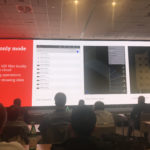Continued from page 2
And to an Open Cloud
Open Cloud, ODA’s brand for common data access (CDA), or a common data environment (CDE), describes industry efforts for an end-to-end single-source, cloud-based project delivery tool, combining all the multiple technologies supported by ODA already but then extends these to the cloud. Interestingly, as several ODA technologies are embedded in additional software solutions, the new ODA Open Cloud capabilities are being adopted by end-users as well.

ODA presents Open Cloud roadmap with the production release this December for AWS, Microsoft Azure and any web server.
Currently, AWS has been supported and Microsoft Azure was presented and supported currently as well, but ODA indicates that any cloud OS, public or private, will work, even self-hosted servers using ODA provided REST API. Again, the ODA Technology Stack provides Open Cloud with an integrated solution to several CAD and BIM formats (ODA authored and supported) for access, viewing, properties, markup, automation, editing, versioning, and collaboration.

Robert Graebert, PhD, CTO, Graebert GmbH presents impressive preliminary Open Cloud development and results.

Robert Graebert, PhD, CTO, Graebert GmbH presents impressive preliminary Open Cloud development and results.
One impressive developer demonstration by Robert Graebert of Graebert GmbH also included an optimization technology by ODA for online graphics (VSF visualized stream format for Open Cloud) loading a 40 MB (.dwg) file on an iPad. The VSF capabilities provide partial indexing for low memory import and low RAM requirements creating online hosted capabilities of large geometric datasets realized.
In Conclusion
The ODA has prepared well for the moment of the oncoming demand for a common data environment, or CDE. They call it Open Cloud. And in ODA form, it’s an open CDA or CDE independent of platform or hardware. It can be owned by a firm, business, or software developer…only ODA membership required.
Your data is yours, on or off the cloud. The ODA has built their technology stack to include base AEC formats like DWG, DGN, IFC and web support. On top of that going forward RCS, RVT, and NWF are included as well.
This technology picture begins to add serious teeth to advancing technology democratization for end-users in AEC through broader universal toolsets and common workflow architectures making strong use of de facto or agreed-upon industry standards for files and data. It will no doubt enable ODA members to accelerate plans to engage the cloud further, or for the first time, as well as facilitate greater interoperability potential for their end-users. We see this work being done by the ODA as playing a critical part towards driving at streamlining workflows and activating the potential to drive at capturing productivity gains in the AEC industry, something sorely missing for three-plus decades.
As for the next evolutions for the ODA beyond this? The ODA will take steps to push into the manufacturing CAD space (MCAD) with the STEP interoperable format (similar structure to ICF in some interesting and convenient ways and the new glTF format (GL Transmission Format based on JSON). The ODA continues to create access and opportunity for open collaboration and innovation—moving toward the digital twin but without proprietary controls or formats.




Reader Comments
LOD is Level of Development and helps defines the amount of detail to the model.
LOD is Level of Development and helps defines the amount of detail to the model.
Comments are closed.